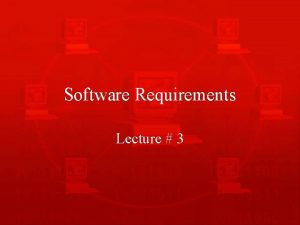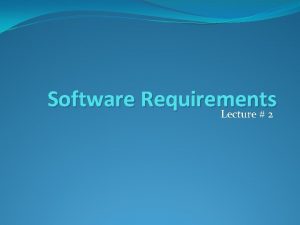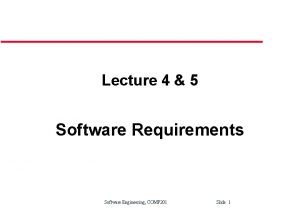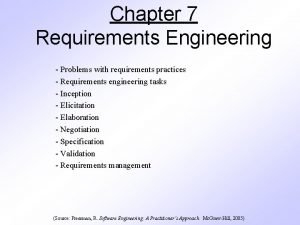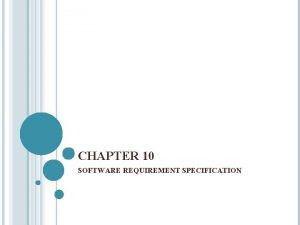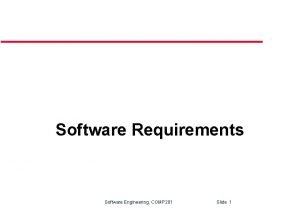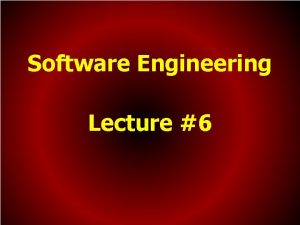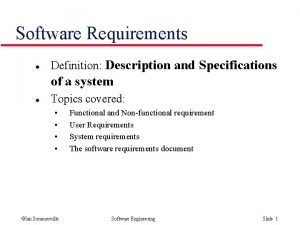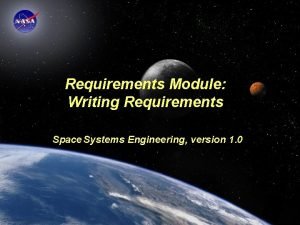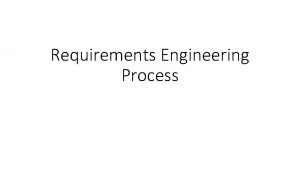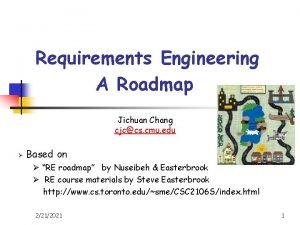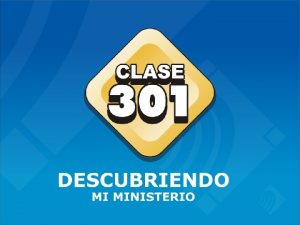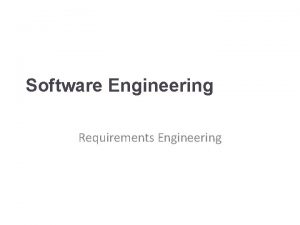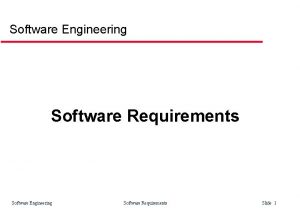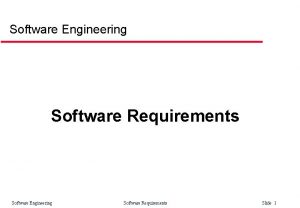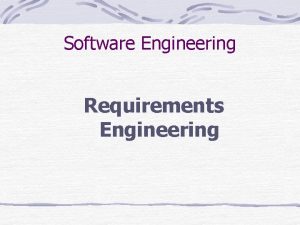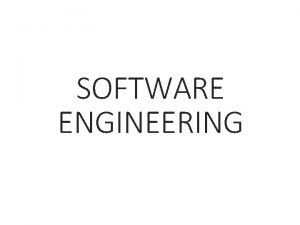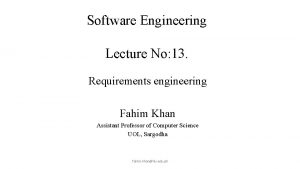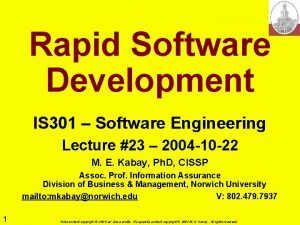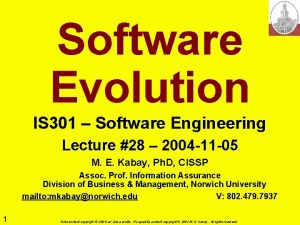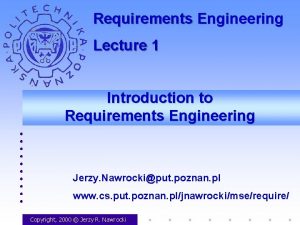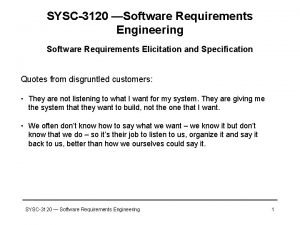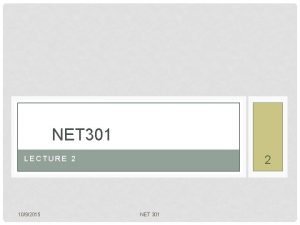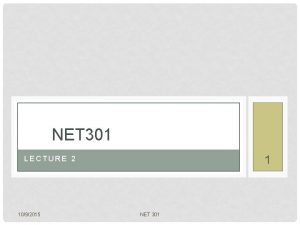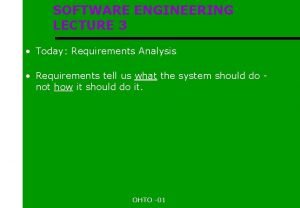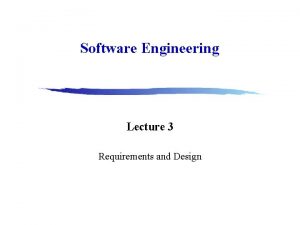Software Requirements IS 301 Software Engineering Lecture 6

























- Slides: 25

Software Requirements IS 301 – Software Engineering Lecture # 6 – 2004 -09 -13 M. E. Kabay, Ph. D, CISSP Assoc. Prof. Information Assurance Division of Business & Management, Norwich University mailto: mkabay@norwich. edu V: 802. 479. 7937 1 Notes content copyright © 2004 Ian Sommerville. NU-specific content copyright © 2004 M. E. Kabay. All rights reserved.

Topics covered Ø Functional and non-functional requirements Ø User requirements Ø System requirements Ø Interface specification Ø The software requirements document 3 Notes content copyright © 2004 Ian Sommerville. NU-specific content copyright © 2004 M. E. Kabay. All rights reserved.

Requirements engineering Ø The process of qestablishing the services that the customer requires from a system and qthe constraints under which it operates and is developed. Ø The requirements themselves are the descriptions of the Ø system services and Ø constraints Ø that are generated during the requirements engineering process. 4 Notes content copyright © 2004 Ian Sommerville. NU-specific content copyright © 2004 M. E. Kabay. All rights reserved.

What is a requirement? Ø It may range from a high-level abstract statement of a service or of a system constraint to a detailed mathematical functional specification. Ø This is inevitable as requirements may serve a dual function q. May be the basis for a bid for a contract therefore must be open to interpretation; q. May be the basis for the contract itself therefore must be defined in detail; q. Both these statements may be called requirements. 5 Notes content copyright © 2004 Ian Sommerville. NU-specific content copyright © 2004 M. E. Kabay. All rights reserved.

Types of requirement Ø User requirements q. Statements in natural language plus diagrams of the services the system provides and its operational constraints. Written for customers. Ø System requirements q. A structured document setting out detailed descriptions of the system’s functions, services and operational constraints. Defines what should be implemented so may be part of a contract between client and contractor. 7 Notes content copyright © 2004 Ian Sommerville. NU-specific content copyright © 2004 M. E. Kabay. All rights reserved.

Functional and non-functional requirements Ø Functional requirements q. Statements of services the system should provide, how the system should react to particular inputs and how the system should behave in particular situations. Ø Non-functional requirements q. Constraints on the services or functions offered by the system such as timing constraints, constraints on the development process, standards, etc. Ø Domain requirements q. Requirements that come from the application domain of the system and that reflect characteristics of that domain. 10 Notes content copyright © 2004 Ian Sommerville. NU-specific content copyright © 2004 M. E. Kabay. All rights reserved.

Non-functional classifications Ø Product requirements q. Requirements which specify that the delivered product must behave in a particular way; e. g. , execution speed, reliability, etc. Ø Organizational requirements q. Requirements which are a consequence of organizational policies and procedures e. g. process standards used, implementation requirements, etc. Ø External requirements q. Requirements which arise from factors which are external to the system and its development process e. g. interoperability requirements, legislative requirements, etc. 17 Notes content copyright © 2004 Ian Sommerville. NU-specific content copyright © 2004 M. E. Kabay. All rights reserved.

Structured presentation Ø 2. 6. 1 Grid facilities Ø The editor shall provide a grid facility where a matrix of horizontal and vertical lines provide a background to the editor window. This grid shall be a passive grid where the alignment of entities is the user's responsibility. Ø Rationale: A grid helps the user to create a tidy diagram with well-spaced entities. Although an active grid, where entities 'snap-to' grid lines can be useful, the positioning is imprecise. The user is the best person to decide where entities should be positioned. Ø Specification: ECLIPSE/WS/Tools/DE/FS Section 5. 6 Ø Source: Ray Wilson, Glasgow Office 33 Notes content copyright © 2004 Ian Sommerville. NU-specific content copyright © 2004 M. E. Kabay. All rights reserved.

Guidelines for writing requirements Ø Invent a standard format and use it for all requirements. Ø Use language in a consistent way. Use shall for mandatory requirements, should for desirable requirements. Ø Use text highlighting to identify key parts of the requirement. Ø Avoid the use of computer jargon. 34 Notes content copyright © 2004 Ian Sommerville. NU-specific content copyright © 2004 M. E. Kabay. All rights reserved.

Problems with Natural Language (NL) specification Ø Ambiguity q. The readers and writers of the requirement must interpret the same words in the same way. NL is naturally ambiguous so this is very difficult. Ø Over-flexibility q. The same thing may be said in a number of different ways in the specification. Ø Lack of modularization q. NL structures are inadequate to structure system requirements. 37 Notes content copyright © 2004 Ian Sommerville. NU-specific content copyright © 2004 M. E. Kabay. All rights reserved.

Structured language specifications Ø The freedom of the requirements writer is limited by a predefined template for requirements. Ø All requirements are written in a standard way. Ø The terminology used in the description may be limited. Ø The advantage is that the most of the expressiveness of natural language is maintained but a degree of uniformity is imposed on the specification. 39 Notes content copyright © 2004 Ian Sommerville. NU-specific content copyright © 2004 M. E. Kabay. All rights reserved.

Form-based specifications Ø Definition of the function or entity. Ø Description of inputs and where they come from. Ø Description of outputs and where they go to. Ø Indication of other entities required. Ø Pre and post conditions (if appropriate). Ø The side effects (if any) of the function. 40 Notes content copyright © 2004 Ian Sommerville. NU-specific content copyright © 2004 M. E. Kabay. All rights reserved.

Sequence diagrams Ø These show the sequence of events that take place during some user interaction with a system. Ø You read them from top to bottom to see the order of the actions that take place. Ø Cash withdrawal from an ATM q. Validate card; q. Handle request; q. Complete transaction. 45 Notes content copyright © 2004 Ian Sommerville. NU-specific content copyright © 2004 M. E. Kabay. All rights reserved.

Sequence diagram of ATM withdrawal 46 Notes content copyright © 2004 Ian Sommerville. NU-specific content copyright © 2004 M. E. Kabay. All rights reserved.

ATM (2) 47 Notes content copyright © 2004 Ian Sommerville. NU-specific content copyright © 2004 M. E. Kabay. All rights reserved.

ATM (3) 48 Notes content copyright © 2004 Ian Sommerville. NU-specific content copyright © 2004 M. E. Kabay. All rights reserved.

ATM (4) 49 Notes content copyright © 2004 Ian Sommerville. NU-specific content copyright © 2004 M. E. Kabay. All rights reserved.

Users of a requirements document (1) 53 Notes content copyright © 2004 Ian Sommerville. NU-specific content copyright © 2004 M. E. Kabay. All rights reserved.

Users of a requirements document (2) 54 Notes content copyright © 2004 Ian Sommerville. NU-specific content copyright © 2004 M. E. Kabay. All rights reserved.

Homework Ø REQUIRED q. By Monday 20 Sep 2004 q 6. 3 (5 pts) q 6. 4 (5 pts) q 6. 5 (5 pts) q 6. 6 (15 pts) Ø OPTIONAL: either or both of the following q. By Monday 27 Sep 2004 q 6. 7 including examples (5 pts) q 6. 8 (5 pts) 59 Notes content copyright © 2004 Ian Sommerville. NU-specific content copyright © 2004 M. E. Kabay. All rights reserved.

DISCUSSION 60 Notes content copyright © 2004 Ian Sommerville. NU-specific content copyright © 2004 M. E. Kabay. All rights reserved.

Notes 61 Notes content copyright © 2004 Ian Sommerville. NU-specific content copyright © 2004 M. E. Kabay. All rights reserved.

Notes 62 Notes content copyright © 2004 Ian Sommerville. NU-specific content copyright © 2004 M. E. Kabay. All rights reserved.

Notes 63 Notes content copyright © 2004 Ian Sommerville. NU-specific content copyright © 2004 M. E. Kabay. All rights reserved.

Notes 64 Notes content copyright © 2004 Ian Sommerville. NU-specific content copyright © 2004 M. E. Kabay. All rights reserved.
 Requirement analysis in software engineering notes
Requirement analysis in software engineering notes 01:640:244 lecture notes - lecture 15: plat, idah, farad
01:640:244 lecture notes - lecture 15: plat, idah, farad Inverse requirements
Inverse requirements Inverse requirements
Inverse requirements Structured specification
Structured specification Requirements discovery techniques in software engineering
Requirements discovery techniques in software engineering Domain requirements in software engineering
Domain requirements in software engineering What is domain requirements
What is domain requirements User requirement
User requirement Problems of requirements in software engineering
Problems of requirements in software engineering Unambiguous requirements in software testing
Unambiguous requirements in software testing User requirements software engineering
User requirements software engineering Source sink analysis
Source sink analysis Requirements in software engineering
Requirements in software engineering System procurement process in software engineering
System procurement process in software engineering Forward engineering and reverse engineering
Forward engineering and reverse engineering Money-time relationship and equivalence
Money-time relationship and equivalence Foundation engineering lecture notes
Foundation engineering lecture notes Engineering ethics lecture notes
Engineering ethics lecture notes Non functional requirements
Non functional requirements Requirements writing for system engineering
Requirements writing for system engineering Requirements engineering process
Requirements engineering process Jichuan chang
Jichuan chang Structured specification
Structured specification Requirement validation in software engineering
Requirement validation in software engineering Lisa lampe uva
Lisa lampe uva


